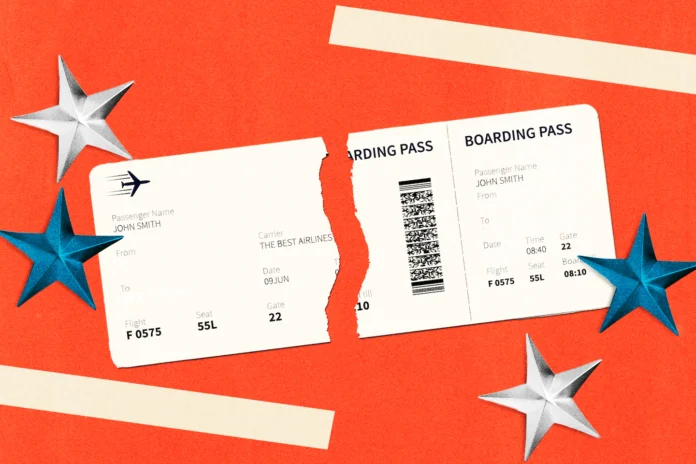Comment on this story
Comment
Airports and roads have been packed this summer, mixing with inflation and labor shortages to create a dreadful travel season marked by high prices, maddening delays and cancellations. According to data forecast by experts, the frenzy is expected to peak ahead of Independence Day.
AAA predicts that 42 million people will travel by car over the Fourth of July weekend, which would set a record despite historically high gas prices. Analysts at Hopper say more than 11 million people are scheduled to fly out of American airports between Thursday and Monday, and the average price of domestic fares ($437 round trip) is higher than it has been in five years.
“I think we will see this year’s passenger travel levels rival those of 2019 — despite airlines having less capacity than they did at that time,” said Adam Gordon, managing director and partner on Boston Consulting Group’s travel team. The number of passengers that have been moving through airport security in June backs that up.
Here’s what travelers who are gearing up for the madness need to know.
To avoid traffic, your best bet is to travel on Thursday before 7 a.m. or after 8 p.m., when the roads have cleared up a bit, AAA spokesperson Ellen Edmonds said.
It’s also safer to travel on Sunday and Monday, days when many travelers are at their destinations and in the thick of their holiday plans.
“Leave during times when traffic will not be as heavy and look for lesser-known routes,” Edmonds suggested, adding that the AAA travel-planning app, TripTik, is a good resource for getting around more-congested areas.
Edmonds said you will probably get stuck in traffic alongside other Fourth of July travelers if you leave between 2 p.m. and 8 p.m. on Thursday or between noon and 9 p.m. on Friday. “It is important that travelers are prepared and flexible to minimize stress and enjoy the holiday,” she added.
The most-congested highways
According to AAA data, the top 10 U.S. driving destinations for the Fourth of July weekend are Orlando, Seattle, New York, Anaheim, Calif., Anchorage, Fort Lauderdale, Fla., Las Vegas, Honolulu, Denver and Chicago.
Drivers who are traveling around major metro areas — such as New York, Los Angeles, Atlanta and Seattle — should be prepared for significantly more delays, according to analytics from INRIX. In Atlanta, for example, southbound Interstate 85 from Clairmont Road to MLK Drive is expected to be 134 percent more congested than normal, with peak traffic on Thursday from 2:30 p.m. to 4:30 p.m. Peak congestion in D.C. is expected to hit Thursday from 3:15 p.m. to 5:15 p.m. for drivers traveling counterclockwise on Interstate 495 from the New Hampshire Avenue exit to Interstate 267.
Avoiding travel on Thursday and Friday afternoon can help travelers stay away from metro-area traffic. Sunday and Monday, however, are expected to have low congestion on the metro-area highways.
A small break on high gas prices
Gas prices have been climbing for months, pushing drivers to be more conscious about the miles they’re putting on their cars. As of Wednesday, the national average was at $4.87 a gallon, down from a record $5.02 in mid June, according to AAA.
One place to find relief? Sheetz. The convenience store announced Monday it would begin running a gas special available through the holiday weekend, dropping the price to $3.99 a gallon for Unleaded 88 and $3.49 a gallon for E85. The Mid-Atlantic chain says it has more than 640 locations across Virginia, Maryland, West Virginia, Pennsylvania, Ohio and North Carolina.
High gas prices affect each state differently, so try to be strategic about where you fill up if you’re going on a road trip. For example, fill up in Arizona instead of California, or Kentucky instead of Indiana.
No matter when you fly, make an effort to get to the airport early.
“Mornings tend to be more reliable times to fly, as there is less of a chance for things like summer weather disruptions across networks,” said Gordan, the travel consultant.
Flying on Saturday of the long weekend and returning on Monday, July 4, is the best bet for the best prices on domestic trips, according to Hopper data. Leaving on Saturday instead of Thursday can save domestic travelers $70 per ticket off the peak prices. For international travelers, Hopper suggests departing on Friday or Saturday to save an average of $160 off peak ticket prices.
More than 2 million people have gone through Transportation Security Administration checkpoints every day since June 5, 2022, and the numbers don’t seem to be slowing down any time soon.
Try to avoid the most common and popular times to fly, from 8 a.m. to 8 p.m. With the increased number of travelers at the airport, flight delays and cancellations are expected to bombard travelers and shake up their plans over the weekend.
“Have a Plan A, B and C,” Edmonds said, especially if you’re flying. She added that travelers should plan for delays or cancellations, and the potential added cost of staying in an unexpected location. To get ahead of issues that may come up, check in 24 hours ahead of your trip and track the status of your flight through the airline’s app.
Where bad weather is expected
Storms aren’t expected to take over the weekend, but there will be a few weather-related obstacles for some travelers.
Moisture from the Atlantic and the Gulf of Mexico is expected to contribute to some afternoon and evening thunderstorms in the interior Southwest and Southeast states, according to AccuWeather. In addition, the moisture might bring storms to part of the northern Rockies, the Midwest and the Northeast, but those storms are expected to be brief, the weather service reported. Be prepared for potential weather delays at the airport if you are flying into any of these areas.
The coronavirus is on the rise again in the United States, with the country reporting a 21 percent overall increase in new cases over the past week, according to tracking data from The Washington Post.
While the testing requirement for international travel into the U.S. has officially ended, health experts say you should still test for coronavirus, ideally within three days of your departure date. Health experts also suggest wearing a mask if you want to protect yourself from the virus, especially in crowded indoor spaces like airports.
If you’re traveling abroad, testing positive for the coronavirus could come with a handful of obstacles, because travel restrictions vary by country. If you test positive, the Centers for Disease Control and Prevention says you’re not supposed to travel for 10 days.










